Poor screen uniformity creates subtle brightness variations, causing clinicians to miss or misinterpret critical details. This inconsistency undermines diagnostic confidence and can compromise patient outcomes.
This article compares Direct-Lit and Edge-Lit backlight systems, covering uniformity standards, design differences, and their impact on DICOM compliance, cost, and specific clinical applications. I will explore how to make informed procurement decisions by balancing performance with budget.
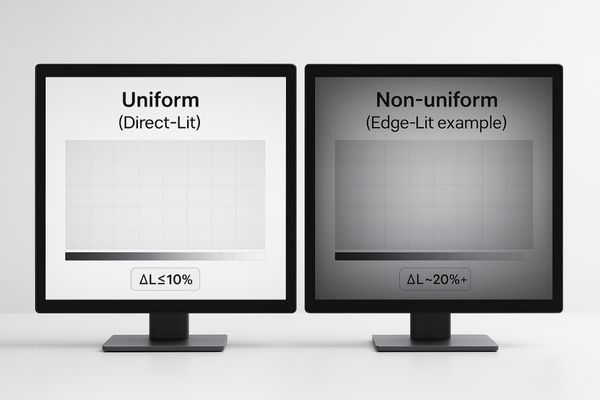
The choice between a Direct-Lit and an Edge-Lit1 backlight system is one of the most fundamental decisions in selecting a medical grade monitor, yet its importance is often underestimated. This is not merely a matter of design preference; it directly influences the diagnostic reliability of the display. Backlight technology determines how evenly luminance is distributed across the entire screen surface. An Edge-Lit system, with LEDs arranged along the borders, must use a light guide plate to spread light, a process that can introduce inconsistencies. In contrast, a Direct-Lit2 system places an array of LEDs directly behind the LCD panel, offering inherently superior control over luminance distribution. For medical imaging, where the slightest shadow or anomaly can be significant, this uniformity is not a luxury. It is a prerequisite for accurate diagnosis and is a core consideration in the engineering of reliable displays like the MD26C. Understanding this core difference is the first step toward making a truly informed procurement choice.
Understanding Luminance Uniformity and Industry Measurement Standards
A monitor can pass calibration at its center point yet fail in the corners. This hidden flaw can lead to inconsistent image interpretation, creating a significant risk in clinical environments.
Luminance uniformity is the consistency of brightness across the screen, measured by standards like AAPM TG18. Understanding these benchmarks allows procurement teams to verify a display’s true diagnostic reliability beyond marketing claims.
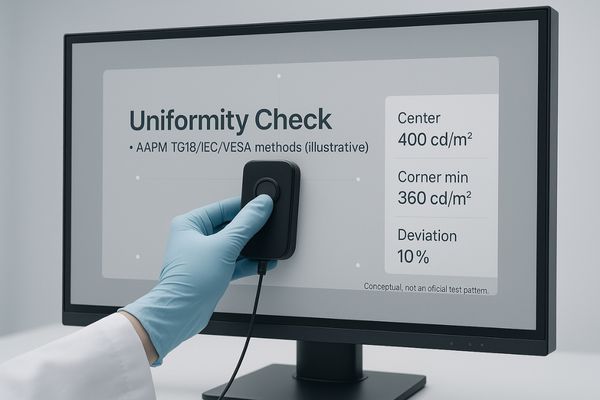
Luminance uniformity is a critical, quantifiable metric that defines the quality of a medical display. It measures the variation in brightness between the center of the screen and its corners and edges. Industry bodies have established specific standards to ensure this consistency. The American Association of Physicists in Medicine (AAPM) Task Group 18 (TG18) provides one of the most widely recognized testing protocols, outlining how to measure and assess uniformity for primary diagnostic displays. The International Electrotechnical Commission (IEC) and the Video Electronics Standards Association (VESA) also provide guidelines. These standards typically require that luminance deviation at any point on the screen does not exceed a certain percentage—often 15% to 20%—of the center luminance. For a high-performance monitor like the MD120C, which is used for complex multi-modality reads, adhering to these strict protocols is non-negotiable. It ensures that a subtle finding visible in one part of an image remains just as visible if it appears in another, safeguarding diagnostic accuracy.
Direct-Lit vs Edge-Lit Backlights: Core Design Differences
Choosing a display based on its thin profile or low price can be misleading. The underlying backlight technology, which is not immediately visible, is what truly dictates its clinical performance.
Direct-Lit backlights place LEDs evenly behind the panel for superior uniformity. Edge-Lit designs place them on the sides for a slimmer profile, but this can compromise brightness consistency across the screen.
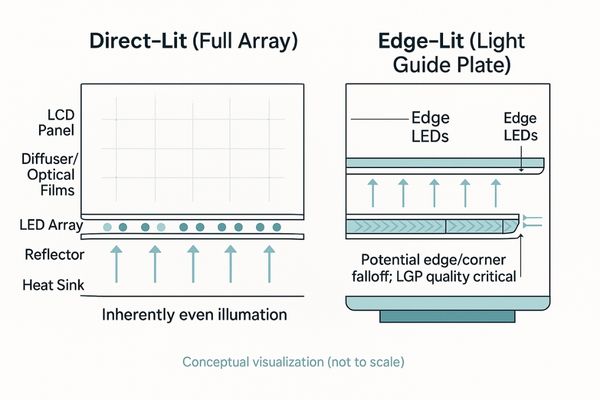
The fundamental difference between Direct-Lit and Edge-Lit3 systems lies in the physical placement of the LED light sources. This single design choice has profound implications for performance, form factor, and cost. In a Direct-Lit system, a full array of LEDs is positioned directly behind the LCD panel, creating a uniform blanket of light. This architecture inherently minimizes brightness drop-off at the edges and provides robust, even illumination. An Edge-Lit system places LEDs along one or more edges of the display and relies on a sophisticated light guide plate (LGP) to channel and distribute the light across the entire screen. While this allows for a much thinner and lighter design, any imperfection in the LGP can create visible artifacts like bright spots or dark corners. For large-format displays like the MD51CHY, where a team of clinicians might review complex cases, the superior uniformity offered by Direct-Lit4 technology is essential for consistent visualization from different angles.
| Feature | Direct-Lit Backlight | Edge-Lit Backlight |
|---|---|---|
| LED Placement | Array directly behind the LCD panel | Along the edges of the panel |
| Uniformity | Inherently high and consistent | Dependent on light guide plate quality |
| Form Factor | Thicker and heavier | Thinner and lighter |
| Heat Management | Heat distributed across the back | Heat concentrated at the edges |
| Ideal Use Case | Primary diagnostic imaging | Clinical review, information display |
Uniformity’s Role in DICOM Calibration and Grayscale Accuracy
A screen can be calibrated to meet DICOM standards at one point. However, if its brightness varies across the display area, that calibration becomes unreliable for real-world use.
Poor uniformity undermines DICOM Part 14 GSDF compliance. Even if a display is calibrated at its center, brightness deviations at the edges can distort grayscale perception and compromise diagnostic reliability.
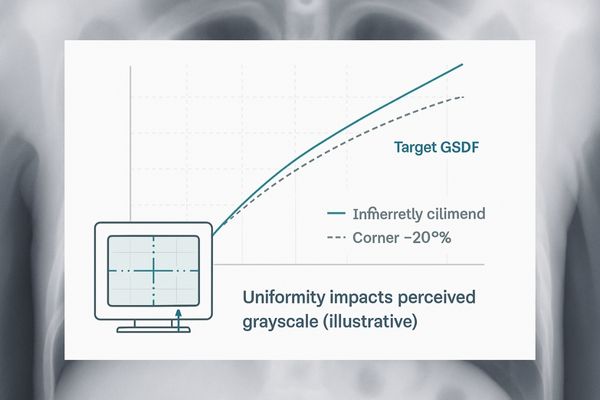
The DICOM Grayscale Standard Display Function (GSDF)5 is the cornerstone of digital medical imaging, ensuring that grayscale values are perceived consistently across different displays. Calibration aims to align a monitor’s luminance response with this standard. However, this process is fundamentally compromised if the monitor lacks good uniformity. A calibration sensor typically measures from the center of the screen. If the corners are 20% dimmer, then the carefully calibrated grayscale steps will be incorrectly rendered in those areas, altering the appearance of tissue densities and potentially masking or mimicking pathology. This is particularly critical in mammography, where detecting subtle microcalcifications demands the highest level of grayscale accuracy. A monitor with superior inherent uniformity, such as the grayscale-specific MD52G, provides a stable foundation for DICOM compliance. It requires less aggressive digital correction, which can introduce artifacts, and ensures that the calibration holds true across every square inch of the screen, providing unwavering diagnostic confidence.
Power Consumption, Heat Management, and Lifecycle Cost
The initial purchase price of a monitor is only one part of its total cost. Higher power consumption and poor heat management can lead to increased operational spending and reliability issues over time.
Direct-Lit displays consume more power but offer stable luminance, while Edge-Lit systems are more energy-efficient and produce less heat. Procurement should consider the total cost of ownership, including energy and maintenance.
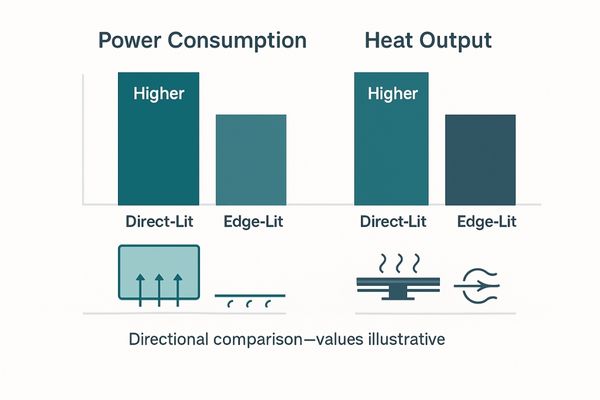
Beyond image quality, backlight technology significantly impacts a display’s total cost of ownership (TCO)6. Direct-Lit systems, with their full array of LEDs, naturally consume more power and generate more heat than their Edge-Lit counterparts. This translates to higher electricity bills and can contribute to a warmer reading room environment, potentially increasing HVAC costs. However, this design also offers better heat dissipation across a larger surface area and component redundancy, which can lead to a more stable luminance output and longer operational life under continuous use. Edge-Lit systems are champions of energy efficiency7, making them an economical choice for large-scale deployments where displays are used intermittently. Their lower heat output also reduces thermal stress on internal components. When selecting a monitor like the MD33G for a busy reading room, balancing its performance with thermal considerations is key to ensuring it operates reliably without contributing excessive heat to the workspace.
| Aspect | Direct-Lit Backlight | Edge-Lit Backlight |
|---|---|---|
| Power Consumption | Higher | Lower |
| Heat Output | Higher, distributed across the back | Lower, concentrated at edges |
| Lifecycle Cost | Higher energy cost | Lower energy cost |
| Long-Term Stability | Generally more stable due to redundancy | Can be susceptible to heat stress at edges |
Application-Specific Backlight Recommendations
Using a single type of display across an entire hospital is inefficient. It leads to overspending on non-critical applications and under-specifying for diagnostic roles, compromising both budget and safety.
Direct-Lit is recommended for high-stakes applications like radiology and mammography. Cost-effective Edge-Lit technology is well-suited for clinical review and general hospital use where uniformity requirements are less stringent.
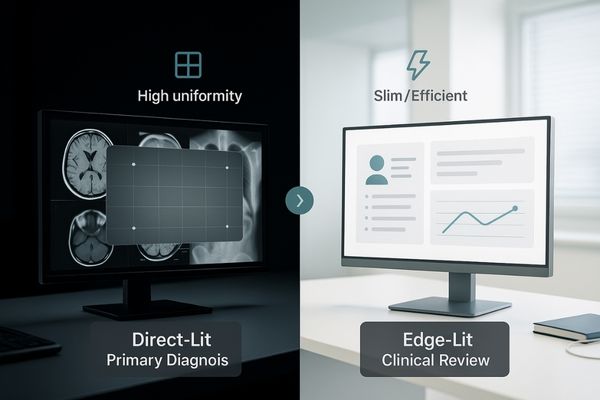
The choice between Direct-Lit and Edge-Lit technology should be guided by clinical application. There is no single "best" solution; there is only the best fit for a specific task. For primary diagnostic radiology and mammography, where the detection of subtle abnormalities relies on perfect image consistency, the superior uniformity of Direct-Lit technology8 is a clinical necessity. Similarly, for multi-modality diagnostic environments using a large display like the MD85CA, it must provide a uniform view to every clinician involved in the consultation, making Direct-Lit the only appropriate choice. Conversely, for clinical review stations, patient rooms, or administrative tasks, the primary requirements are clarity and cost-effectiveness. In these scenarios, the slim design and lower power consumption of an Edge-Lit display9 make it a perfectly suitable and financially prudent option. A tiered procurement strategy—matching the backlight technology to the clinical risk—is the most effective way to optimize performance and budget.
The Emerging Role of Mini-LED and Hybrid Backlight Solutions
Relying solely on traditional backlight technologies may mean missing out on innovations. New solutions are emerging that bridge the gap between existing designs, offering a better blend of performance and form factor.
Mini-LED technology offers a path to achieving Direct-Lit performance in a slim, Edge-Lit-like profile. This hybrid approach represents a future-proof investment for applications where both image quality and space are critical.
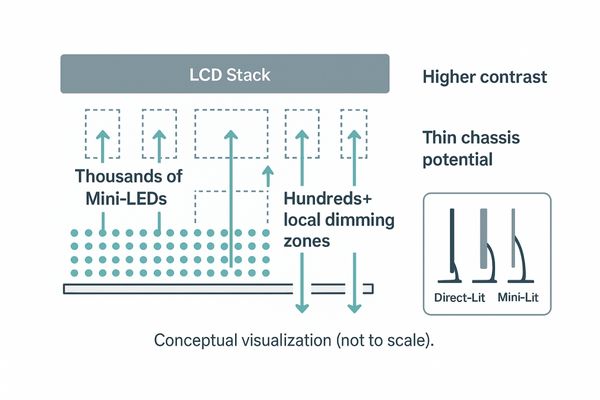
The evolution of backlight technology continues, with Mini-LED emerging as a significant innovation. Mini-LED technology uses thousands of much smaller LEDs to create a Direct-Lit array10 with hundreds or even thousands of local dimming zones. This design offers the best of both worlds: it approaches the granular luminance control and high uniformity of Direct-Lit systems while enabling a much thinner profile, closer to that of an Edge-Lit display. The increased number of dimming zones also allows for dramatically improved contrast ratios and deeper blacks, rivaling the performance of OLED without the associated risk of burn-in. For hospitals planning long-term technology roadmaps, monitors incorporating Mini-LED11 or other advanced hybrid solutions represent a smart, future-proof investment. A state-of-the-art monitor like the MD50C, designed for demanding color-enhanced mammography or digital pathology, could leverage such technology to deliver next-generation performance.
Strategic Procurement: Balancing Performance, Compliance, and Budget
Choosing a medical display based on a single metric—be it price or a specific feature—is a flawed strategy. This narrow focus fails to account for the diverse needs of a modern healthcare institution.
A strategic approach to procurement aligns the backlight technology with clinical importance. This avoids over-specifying for low-risk roles and under-specifying for critical diagnostics, thereby maximizing budget efficiency and ensuring compliance.
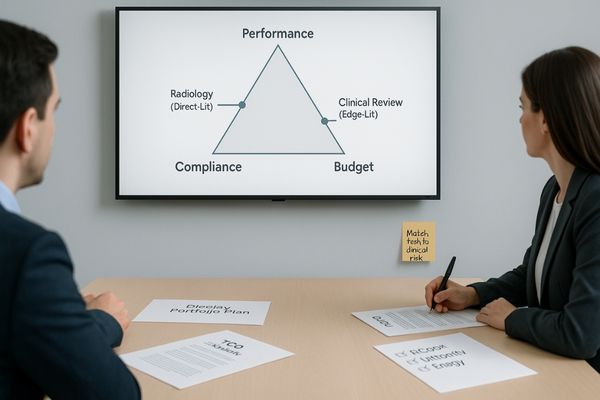
Ultimately, the decision between Direct-Lit and Edge-Lit technology is a strategic one that should balance three competing priorities: clinical performance, regulatory compliance, and budget constraints. A sophisticated procurement strategy creates a diversified display portfolio tailored to the hospital’s specific needs. It recognizes that a premium Direct-Lit12 diagnostic monitor is essential for the radiology department, but a reliable Edge-Lit13 clinical review display like the MD22CA is a more appropriate and cost-effective choice for ward-based image viewing. This approach prevents the common pitfall of over-specifying monitors for non-critical roles, which wastes capital that could be better allocated elsewhere. It also prevents the far more dangerous mistake of deploying under-performing displays in diagnostic environments. By matching the technology to the task, international distributors and hospital procurement teams can build a sustainable, compliant, and cost-effective medical imaging infrastructure that safeguards both patient safety and the bottom line.
Conclusion
Choosing the right backlight technology is a strategic decision that directly impacts diagnostic accuracy, operational cost, and clinical compliance, requiring a balanced, application-specific procurement approach.
📧 Need guidance on selecting the optimal backlight technology for your clinical needs? Contact Martin at martin@reshinmonitors.com to explore Reshin’s tailored medical display solutions.
-
Learn about Edge-Lit technology’s impact on display performance, crucial for accurate medical imaging and diagnosis. ↩
-
Explore the benefits of Direct-Lit systems for medical monitors to ensure optimal diagnostic reliability and luminance control. ↩
-
Learn about Edge-Lit technology to see how it enables thinner designs and the challenges it presents in display quality. ↩
-
Explore the benefits of Direct-Lit systems to understand why they provide superior uniformity and performance in displays. ↩
-
Understanding GSDF is crucial for ensuring consistent grayscale perception in medical imaging, which directly impacts diagnostic accuracy. ↩
-
Understanding TCO helps in making informed decisions about display investments, ensuring long-term savings. ↩
-
Exploring energy efficiency can reveal cost-saving benefits and environmental impacts, crucial for sustainable choices. ↩
-
Explore this link to understand how Direct-Lit technology enhances image consistency and uniformity in clinical settings. ↩
-
Discover why Edge-Lit displays are ideal for clarity and cost-effectiveness in various clinical environments. ↩
-
Learn about Direct-Lit arrays and their advantages in achieving better luminance control and uniformity in displays. ↩
-
Explore this link to understand how Mini-LED technology enhances display performance and offers superior contrast ratios. ↩
-
Explore the benefits of Direct-Lit technology to understand its impact on clinical performance and patient safety. ↩
-
Learn about Edge-Lit technology’s cost-effectiveness and suitability for various medical imaging tasks. ↩

